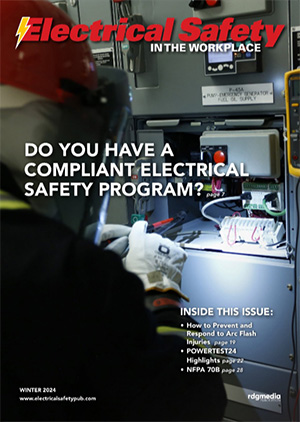NFPA 70B: A Monumental Shift in Electrical Safety
Shifting from a recommended practice to a standard involves much more than a name change.
By: Derek Vigstol, Contributor
A little over a year ago, the electrical industry got a sort of upgrade that many of us were unaware of on the horizon. That upgrade came in the form of NFPA 70B changing from the recommended practice for electrical equipment maintenance, to the standard for electrical equipment maintenance.
However, this was a much bigger shift than just changing a name. For those of us in the know on how National Fire Protection Association (NFPA) documents are classified as a Code, Standard, Recommended Practice or Guideline; this was a very big deal. But, what does it mean for everyone else? And more importantly, what does this have to do with safety? Afterall, this is an electrical safety publication, right?
THE IMPACT ON THE INDUSTRY
First, let’s explore the impact for the industry on going from a recommended practice to a standard. This change at a high level might appear as though the committee for NFPA 70B simply went through and changed “should” to “shall” and called it a day. Well, if it were even remotely that easy, it would have only taken a fraction of the time that it did to make this change.
The reality is that the committee on electrical equipment maintenance spent years of hard work reviewing the original document and deciding how best to make the shift. It involved a lot of hard work by the committee to make such an important final product. What needed to be done was a complete rethinking of the entire structure of the document to develop a format that would make sense.
One of the major structural revisions is that the information contained in the recommended practice had to be divided into three types of information:
- Information that was an action item or that could be re-written as a requirement such as, “An electrical maintenance program (EMP) is important and can delay the inevitable equipment failure” could be changed to, “An equipment owner shall develop and implement an overall EMP.”
- Information that is explanatory or Annex material that helps with the implementation of an action item or requirement.
- Extraneous information that is maybe good to know but not necessary for inclusion in the standard.
As you can probably imagine, this took a ton of hard work to sift through all of it. However, that hard work paid off and out of it came a standard that states, “If you own electrical equipment, here is how you can maintain it to reduce the risk of equipment failure that could cause injury to employees or unnecessary reliability issues.”
WHAT IT MEANS FOR EMPLOYEES
It is the part about the reduced risk of injury to employees that grabs the attention of this author and has me so excited about this new document. Sure, NFPA 70E®: Standard for Electrical Safety in the Workplace® has an entire chapter devoted to safety-related maintenance, but it isn’t the same.
Take for instance Article 225 for fuse and circuit breaker maintenance. The entire article is basically “Fuses and circuit breakers shall be maintained and free from breaks or cracks and if a circuit breaker is involved in a fault, it must be tested in accordance with the manufacturer’s instructions.”
NFPA 70B on the other hand has Chapter 15 which goes into detail on what sort of visual inspections to perform, lubrication needed, tests that need to be run for larger low-voltage and medium-voltage circuit breakers, and it references where we can go to find an interval for how often to do this. When we look at how important the role of an overcurrent protective device is in interrupting an arcing fault or arc flash, we need this more in-depth take on how to ensure they operate as intended.
In fact, the shift of NFPA 70B to a standard might be one of the largest improvements in electrical safety in the workplace since the Williams-Steiger Occupational Safety and Health Act was signed into law by President Nixon in 1970. Proper installation and safe work practices have been requirements for some time but they didn’t amount to much in 25-30 years if the working condition of the equipment had not been maintained.
The recommended practice was a good start but was never ready for prime time and the Occupational Safety and Health Administration (OSHA) certainly wasn’t going to reference employers to a recommended practice the way they reference an industry consensus standard such as NFPA 70E.
WHAT IT MEANS FOR EMPLOYERS
So, what does this mean for employers that own and/or operate electrical equipment within their facility going forward? Simply put, it is time that we stop thinking that big grey box in our electrical room is fine on its own. The days of “If it ain’t broke, don’t fix it!” have come to an end in the electrical world.
The first thing to look at is our electrical equipment maintenance program or what NFPA 70B refers to as an EMP. And if you are reading this and asking, “What’s an EMP?” then you most likely don’t have one and might need to look into getting one.
An EMP is an overall document that the equipment owner must develop to direct activities appropriate to electrical equipment maintenance to maintain a safe and reliable working environment. Think of it like an electrical safety program, but for maintenance. In fact, the two are so closely related, it is almost impossible to write one without the other!
NFPA 70B requires the equipment owner to draft this plan based on the specific equipment in the facility. This allows the equipment owner to account for their specific needs and situation when deciding the best plan for maintaining their electrical equipment. For instance, a chemical manufacturing plant might have a different need for maintenance than a retail shopping center. Equipment failure in the plant might lead to a situation where the surrounding community is exposed to dangerous chemicals versus at the shopping center where failure of the equipment might simply mean that shoppers can’t purchase that new pair of sneakers because the point-of-sale system is down. One instance is a risk to the health and safety of many people whereas the other is a minor inconvenience. By drafting their own EMP, the equipment owner can weigh these types of concerns.
THE IMPACT Of ELECTRICAL EQUIPMENT MAINTENANCE
Whatever your approach towards electrical equipment maintenance has been over the years, the one thing we can’t deny is that taking care of our equipment helps keep us safe when we go to work. It will also make sure the lights come on when we flip the switch. This makes it easy to see that one of the most important procedures we can perform in our daily routine is taking care of our electrical equipment as both safety and reliability are critical to the successful operation of a business. When it comes to electrical equipment, never forget that old saying, “An ounce of prevention is worth a pound of cure.” Take care of your equipment and it will take care of you. ESW
Derek Vigstol is an electrical safety consultant for e-Hazard and the co-host of e-Hazard’s electrical safety focused podcast, Plugged Into Safety. For more information, visit www.e-Hazard.com
Share on Socials!
What Are Absence of Voltage Testers and How Are They Used?
Electrical Safety Statistics: Why Are Workers Still Dying on the Job
Setting The Record Straight: Equipment Safety in Hazardous Areas
Leaders in Electrical Safety
• Aramark
• Bowtie Engineering
• Enespro
• Ericson
• I-Gard Corporation
• IRISS
• KERMEL, INC.
• Lakeland Industries
• MELTRIC Corporation
• National Safety Apparel
• National Technology Transfer
• Oberon
• Saf-T-Gard
• SEAM Group
Subscribe!
Sign up to receive our industry publications for FREE!







